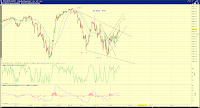Stocks
Chart S1 summarizes three key scenarios to watch since the 2009 low in stocks, with the assumption that the advance likely traces out an impulse wave when done (see 2015 Outlook(1/2/15)).
[green - very bullish] Wave [3] ended at the turn of 2014 and wave [4] ended at the October 2014 low. See What if wave three ended a year ago? (1/9/15) The sell-off in January is wave (2)-down of wave [5]-up. Expect a wave (3) advance when wave (2) is complete.
[blue - bullish] Wave (5) of wave [3] is tracing out an expanding diagonal triangle. The sell-off in January is wave [b] of wave E of wave (5) of wave [3]. Expect a final wave [c] advance to conclude wave [3]. See Chart S2 for details.
An immediately bearish, but less likely, alternative under this interpretation is that wave [3] actually ended a the recent high in SP500 with a very short lived wave [c] of E(5)[3].
[red - bearish] Wave [3] ended at the turn of 2014 but wave [4] requires one final decline, likely targeting somewhere between 1800 and 1900 in SP500. The sell-off in January marked the beginning of this final decline.
Bonds
Chart B1 tracks two long term scenarios for the 10Y Treasury yield index.
[green] Yields bottomed in 2012 after a 30-year 13-wave decline. After rising to an initial high towards the end of 2013, the 10Y yield experienced a very deep pullback in the form of a double zigzag shown in Chart B2. In this case, expect U.S. long term rates to rise before long.
[blue] The decline since the 2007 high in yield is tracing out an contracting ending diagonal triangle. the final wave of the proposed EDT is in progress towards the lower blue trend line for an overthrow. In this case, expect U.S. long term rates to follow European rates lower.
USD
Chart $1 tracks two long term scenarios for the USD index.
[green] An upward flat has been in progress since the 2008 low in the USD index. Wave (B) of the upward flat ended at the 2011 low. The dollar index has now recovered half of its 2001-2008 loss. Wave (C) is either wrapping up its green wave 3 or in the middle of a very extended green wave 3. Chart $2 illustrates.
[red] An upward flat has been in progress since the 2008 low in the USD index. Wave (B) of the upward flat ended at the 2014 low, taking the form of a complex W-X-Y pullback. Wave (C) is now approaching equality with wave (A) and faces potential channel line resistance.
Gold
Gold, in USD terms, needs to clear the June 2014 high around 1350 to break above its two-year range. Otherwise, Gold remains susceptible to several bearish scenarios to conclude wave C off the 2012 high. See Chart G1.
[green C] expanding EDT off the March 2014 high.
[black C] a zigzag or a regular five-wave decline off the 2013-2014 contracting triangle.
[red C] final wave [e] of a large EDT dating back to the 2012 high.
Meanwhile, Gold priced in euro and yen faces potential lateral or trend channel resistance as shown in Chart G2 and Chart G3.







































